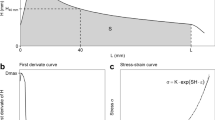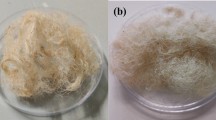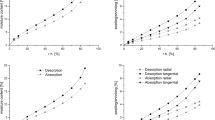Abstract
DERIVATIONS of the differential heat of sorption of dry textile fibres (ΔH0) from measurements of heat of wetting have yielded values which are approximately equal for the cellulosic fibres (c. 250–300 cal./gm.). This has been taken to imply that the type of reaction, that is, hydroxyl bonding with water, is similar for all cellulosic fibres, and that varying hygroscopicity is dependent on the relative amount of material within the fibre which is available for moisture sorption1–4.
This is a preview of subscription content, access via your institution
Access options
Subscribe to this journal
Receive 51 print issues and online access
$199.00 per year
only $3.90 per issue
Buy this article
- Purchase on Springer Link
- Instant access to full article PDF
Prices may be subject to local taxes which are calculated during checkout
Similar content being viewed by others
References
Hermans, P. H., “A Contribution to the Physics of Cellulose Fibres”, 37 (Elsevier, 1946).
Rose, L., J. Text. Inst., 40, P1036 (1949).
Rees, W. H., J. Text. Inst., 39, T351, (1948).
Guthrie, J. C., J. Text. Inst., 40, T489 (1949).
Mainly from Meredith, R., J. Text. Inst., 36, T107 (1945).
Author information
Authors and Affiliations
Rights and permissions
About this article
Cite this article
ASHPOLE, D. Correlation between Initial Young's Modulus and Differential Heat of Sorption at Zero Regain for Cellulosic Fibres. Nature 169, 37–38 (1952). https://doi.org/10.1038/169037c0
Issue Date:
DOI: https://doi.org/10.1038/169037c0
Comments
By submitting a comment you agree to abide by our Terms and Community Guidelines. If you find something abusive or that does not comply with our terms or guidelines please flag it as inappropriate.



